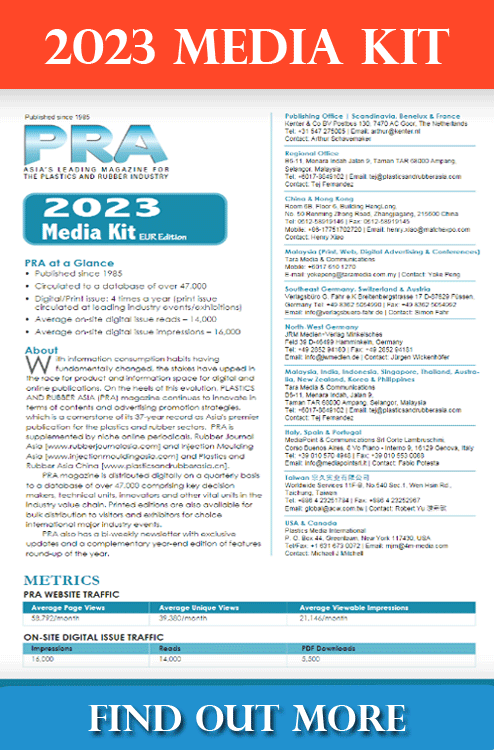New technologies to push the recycling agenda
Recent industry developments in recycling technologies and collaborations are focused on improving recycling rates and recycled material quality, and increasing recycled content in products, says Angelica Buan in this report.
Wastes still rising even with recycling
Whenever the staggering amount of waste plastics is mentioned, recycling comes to mind as a solution. No doubt that recycling offers the sweet spot in reducing wastes.
Recycling conserves resources by converting used materials into new products, reducing the need to consume natural resources; it saves energy because manufacturing with recycled materials requires significantly less energy than manufacturing new products from raw materials; it reduces the need for raw material extraction, which pollutes the air and water; and it conserves energy while lowering greenhouse gas emissions.
However, it is clear that current recycling rates have not kept up with the rate of plastic waste production.
Citing data from the UN, the production of 400 million tonnes/year of plastic waste is only the tip of the iceberg when it comes to the enormous environmental problem that must be addressed.
Single-use plastics (SUPs) contribute to the mounting waste. Every minute, 1 million plastic bottles are purchased globally, and up to 5 trillion plastic bags are used annually. All of these will almost certainly be discarded after use.
According to the OECD's Global Plastics Outlook report, only 9% of plastics are successfully recycled today, with the remaining 22% being mismanaged. Of that, 15% is collected for recycling, but 40% is discarded as waste.

Some plastic materials are not recyclable
Recycling, according to Greenpeace USA, is a "dead end street" in terms of reducing the amount of plastic waste in the environment. Or, in the case of most plastics, recycling is ineffective. Circular Claims Fall Flat Again, a report released in October 2022, stated that a majority of plastics cannot be recycled.
No type of plastic packaging in the US meets the Ellen MacArthur Foundation's New Plastic Economy (EMF NPE) Initiative's 30% recycling rate criteria to be classified as "recyclable."
Commonly used resins in bottles and containers in the US, PET #1 and HDPE #2, and previously thought to be recyclable, have reprocessing rates of 20.9% and 10.3%, respectively. Every other type of plastic has a reprocessing rate of less than 5%.
Similarly, mechanical and chemical recycling of plastic waste have failed because plastic waste is difficult to collect and sort for recycling, is environmentally hazardous to reprocess, often consists of and is contaminated by toxic materials, and is not economically viable to recycle.
According to the report, paper, cardboard, metal, and glass do not have these issues, which is why they are recycled at much higher rates.
Also is the fact that post-consumer recycled (PCR) plastic from household waste poses toxicity risks and is not produced on a commercial scale for food-grade uses anywhere in the world, including the US. As a result of its findings, the organisation deemed that the real solution is to switch to reusing and refilling systems.
Advanced sorting for flexible packaging

Choosing which plastic items are accepted in recycling facilities or can be recycled is a difficult task in itself. That is why, sorting plastic waste is critical if recycling rates are to improve, with high purity rates that are free of contaminated and non- recyclable items. Advanced sorting technologies enable more efficient and effective sorting that is less complex and uses less energy.
The EU-funded Circular FoodPack, which addresses the challenge of recycling flexible packaging with multilayer composites, is one of the most recent developments in the European recycling sector.
The Circular FoodPack project, which started in June 2021 and will end in November 2024, will be implemented by 14 businesses and research centres from six different European nations, with the Fraunhofer Institute for Process Engineering and Packaging serving as the project coordinator.
Flexible plastic packaging is used in food and personal care because of its ability to meet safety and hygiene standards. However, modern sorting and recycling processes are incapable of reliably sorting and recycling flexible packaging with multi-layer film structures.
As a result, the majority of multi-material composites are disposed of in landfills or used for energy recovery. Furthermore, EU legislation prohibits the use of recyclates in food packaging applications.
Circular FoodPack's Tracer-based sorting systems are being further developed to separate food from non-food packaging as well as improve mechanical and physical recycling processes. The project is also developing eco- design innovative mono-material food and personal care packaging that is easy to sort and recycle.
Tracer-based sorting identifies packaging items that contain unique printed, fluorescent tracers that emit an unambiguous signal when exposed to laser light, resulting in the assignment of a material-specific sorting code.
The mechanical and physical solvent-based recycling process cascades will allow Circular FoodPack to purify the recyclates, resulting in a reduction of contaminants, colour, and odour.
A promising deinking technology that can remove all types of inks while also ensuring deodourisation will be scaled up in the existing mechanical treatment cascades. The cleaned material is then recycled using solvents through the patented CreaSolv Process for separation into various material components such as fillers, additives and PE.
At the same time, the project aims to create a recyclable and reusable packaging material containing at least 50% PCR materials, with applications in dry food packaging, home care, and personal care packaging.
The project ensures that all newly developed process steps and (by-) products are subjected to comprehensive sustainability assessments that take into account the entire life cycle, including environmental, economic, and social impacts. This will allow evidence of the new packaging's sustainability to be compared to advance multi- layer multi-material packaging.
(PRA)
Subscribe to Get the Latest Updates from PRA Please click here
©2023 Plastics and Rubber Asia. All rights reserved.

©2023 Plastics and Rubber Asia. All rights reserved.
Home Terms & Conditions Privacy Policy Webmail Site Map About Us






















